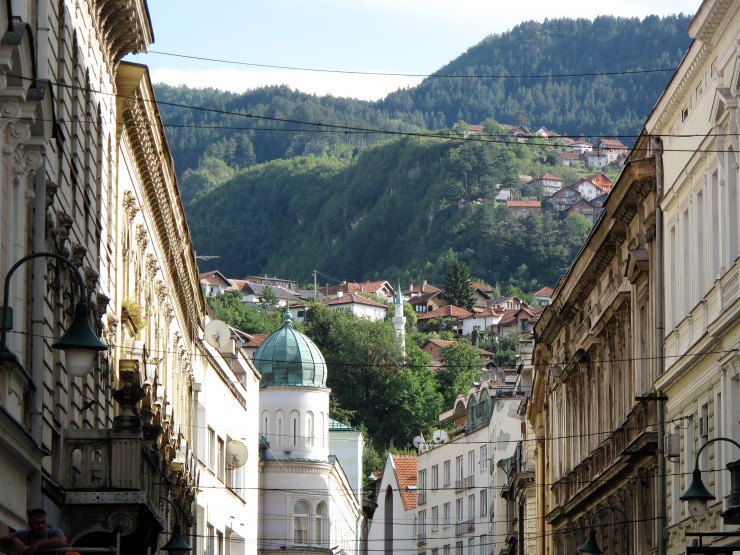
Today we have a 5:30 am departure, and we’re on our way to the beautiful country of Bosnia and Herzegovina. As soon as we cross the border, the landscape changes….mountains, pretty rivers and lakes in between them.
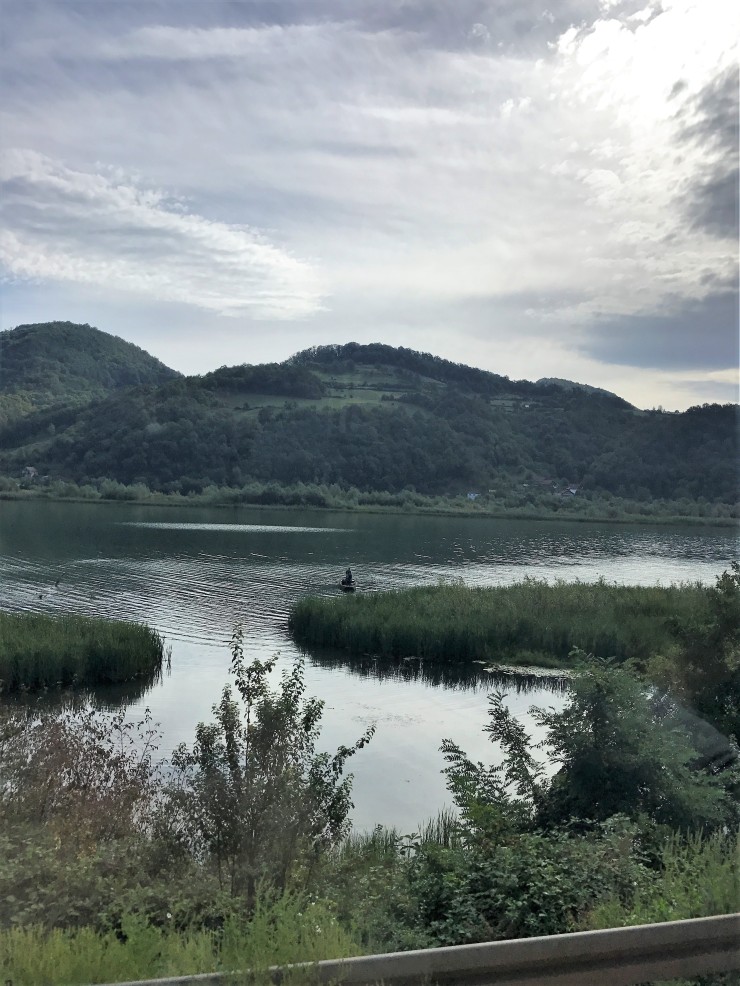 Bosnia and Herzegovina was once part of Yugoslavia, and became independent in 1992. The last 20 years have involved rebuilding after the Bosnian War(1992-1996), which I will discuss later in the blog.
Bosnia and Herzegovina was once part of Yugoslavia, and became independent in 1992. The last 20 years have involved rebuilding after the Bosnian War(1992-1996), which I will discuss later in the blog.
Arriving into Sarajevo by bus, the city sprawls beneath us in the Sarajevo Valley. Vid decides that we will hop off the bus on the side of the road at an unscheduled stop. This allows us to walk down into Stari Grad, the Old Town, where we will be staying for the next 2 days. We check into Pansion Kod Keme, and our lovely host welcomes us with tea. I don’t recall her name, but she is the sweetest person I’ve met so far on this trip. She was born in Bosnia, then lived in Australia, and then returned. She is a survivor of the Bosnian war. As we are curious to learn more, we ask questions on what it was like to live here during that time. She told us part of her story, and how her family was lucky…everyone survived and their house (this hotel) was not damaged. A tear rolled down her cheek as she recalled moments of fear and relief. A powerful moment.
Outside our hotel sits our city guide, Muhamed. He is a super cool guy…dressed in a plaid shirt and shorts, with a shaggy beard and pretty green eyes. He will be our guide to Sarajevo for the next 2 days, and will eventually become a great friend of mine! We walk down the street and around the corner from the hotel, a spot that we passed earlier upon arriving. Little did I know that this is a significant spot in history. It is where Archduke Franz Ferdinand, heir to the Austro – Hungarian throne, was assassinated by Gavrilo Princip on June 28, 1914. He was part of a group who wanted to end Austro-Hungarian rule in Bosnia. This event would start World War I. Today, there is a museum and a plaque outside on the wall for remembrance.
A short walk then leads us to Gazi Husrev-beg Mosque. It is the largest, and main congregational mosque in the country. Due to being ruled by the Ottoman Empire up until the late 19th century, a large part of the population here is Muslim. Mixed in with Christianity, Judaism, and Orthodox, it is a peaceful and respectful mix of religions. The 47m minaret stands tall over the Old Town; the domes of the mosque gleaming in the sunlight that peeks through the trees. It suffered destruction during the Bosnian war and has since been refurbished. I do not get a chance to go inside, as there are specific times which it is allowed.
The 47m minaret stands tall over the Old Town; the domes of the mosque gleaming in the sunlight that peeks through the trees. It suffered destruction during the Bosnian war and has since been refurbished. I do not get a chance to go inside, as there are specific times which it is allowed.
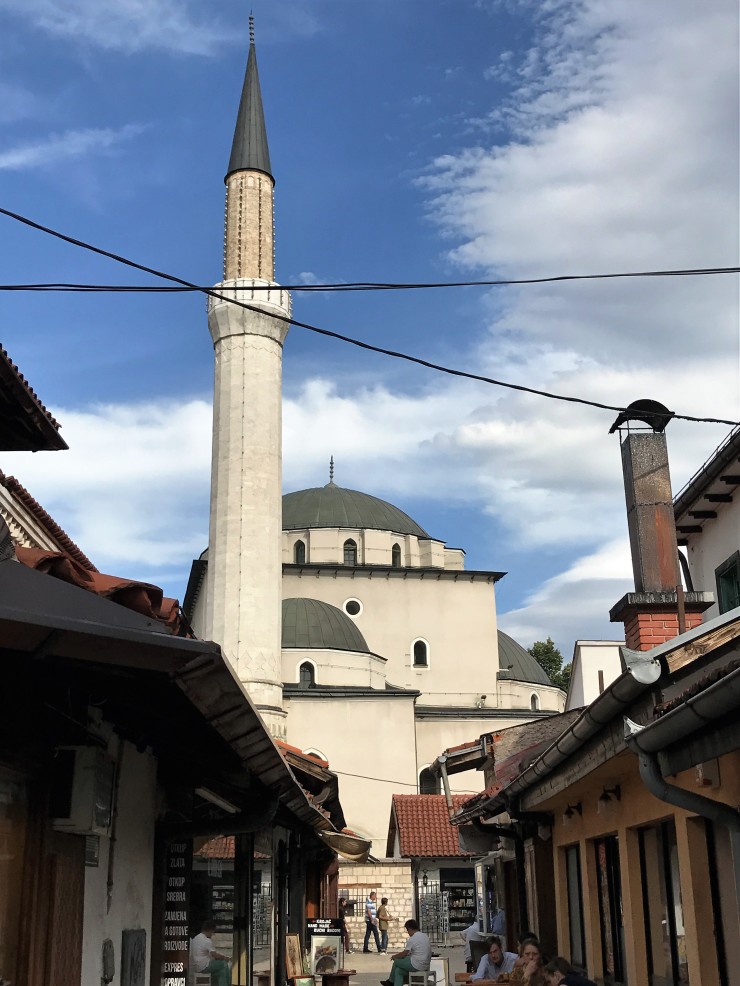
The mosque is located in Bascarsija, the old bazaar and historical and cultural centre of the city. It dates back to the 15th century, and it seems not much has changed.
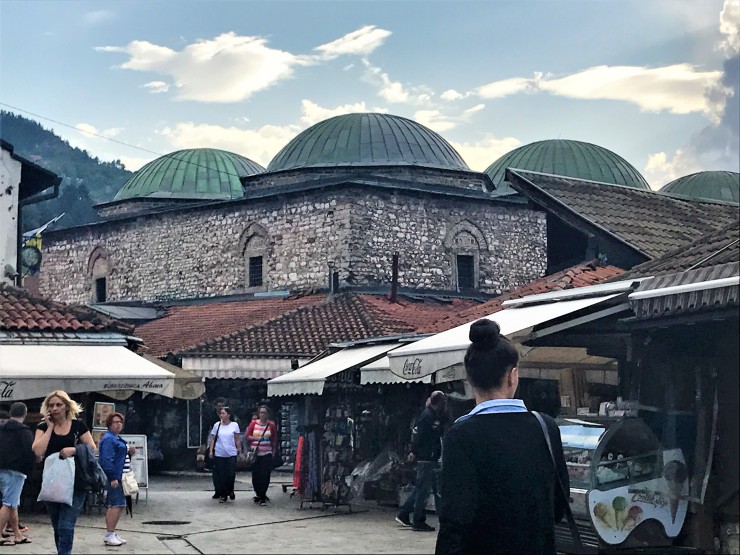
 Old shops still remain, selling souvenirs and traditional goods and there are plenty of restaurants serving authentic Bosnian cuisine. Through the narrow alleyways and cobblestone streets we come to the main square of the bazaar, and there is a landmark that is frequently photographed…the Sebilj, an Ottoman wooden style fountain.
Old shops still remain, selling souvenirs and traditional goods and there are plenty of restaurants serving authentic Bosnian cuisine. Through the narrow alleyways and cobblestone streets we come to the main square of the bazaar, and there is a landmark that is frequently photographed…the Sebilj, an Ottoman wooden style fountain.
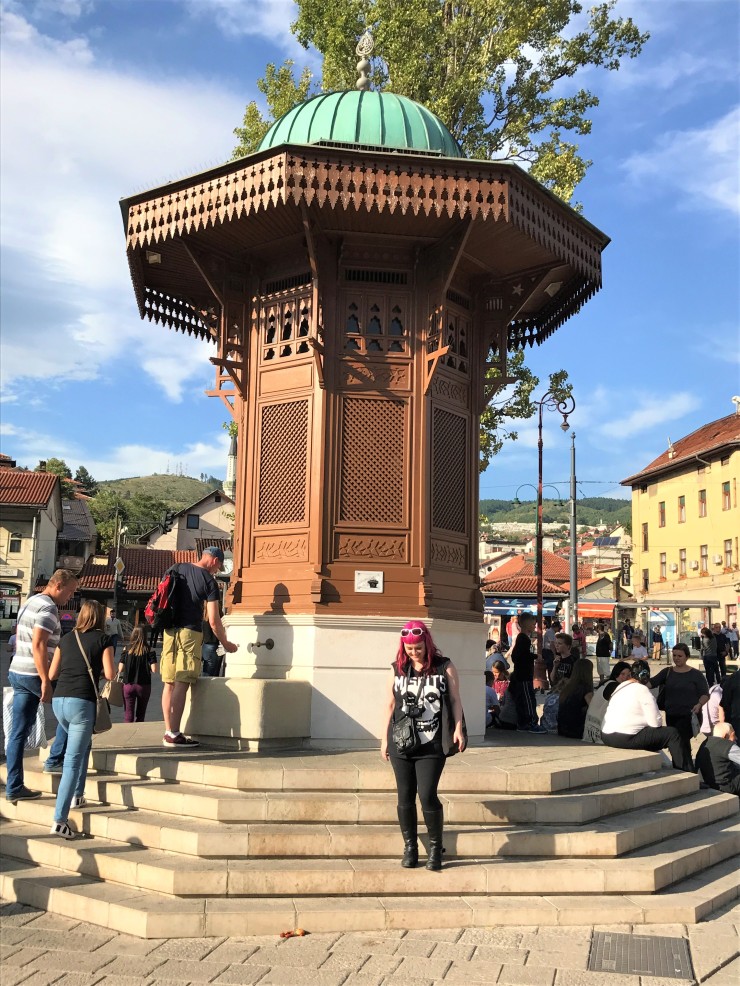 There are usually a lot of pigeons around to be fed, but not so much today. As we continue down another paved street, a painted marker appears. It says “Sarajevo – Meeting of Cultures”. Where East meets West. If you look one way, you’ll see the Ottoman/Islamic influence in the Bascarsija and if you look the other way, you’ll see the more modern Austro Hungarian influence.
There are usually a lot of pigeons around to be fed, but not so much today. As we continue down another paved street, a painted marker appears. It says “Sarajevo – Meeting of Cultures”. Where East meets West. If you look one way, you’ll see the Ottoman/Islamic influence in the Bascarsija and if you look the other way, you’ll see the more modern Austro Hungarian influence.
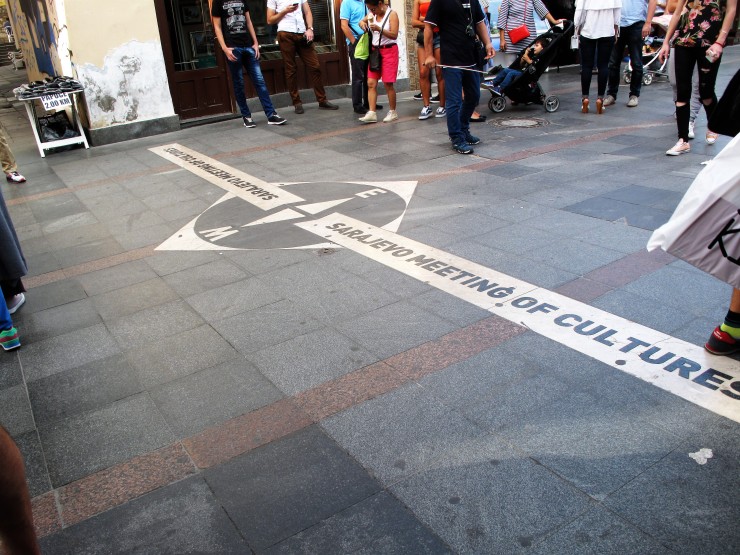
Heading down the street towards the west, out of nowhere, hidden behind buildings, is the most beautiful church. The Sacred Heart Cathedral is a gothic style Roman Catholic church.
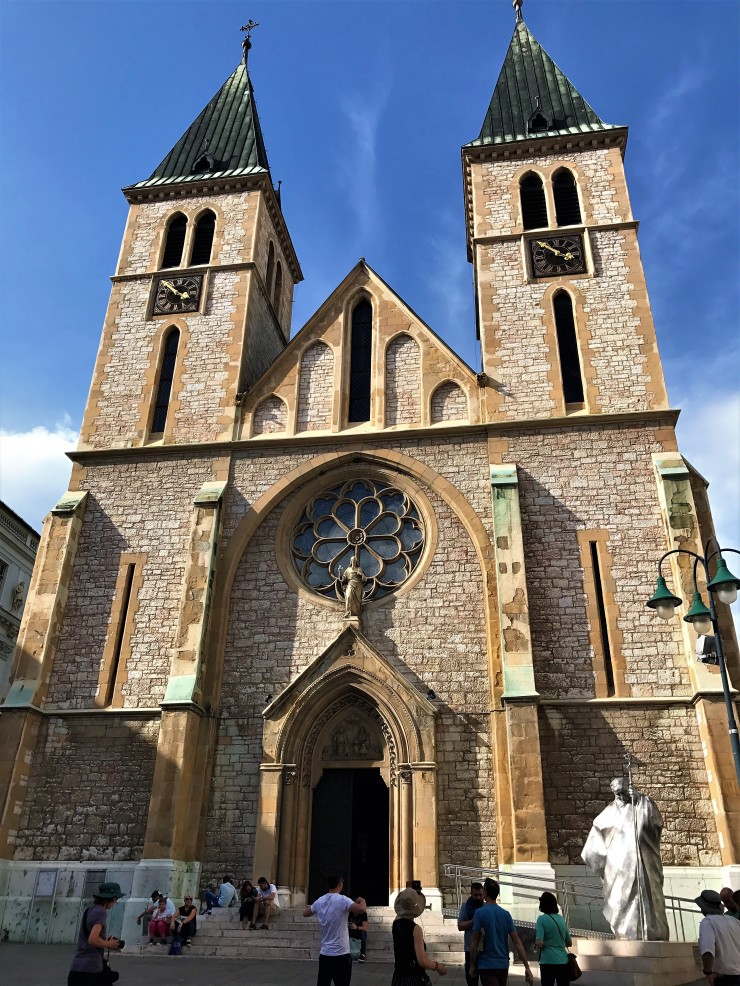 Out front, a large aluminum statue of Pope John Paul II stands tall, a new addition as of 2014. In front of the church is a large explosion mark in the concrete, a reminder of the Bosnian War. There is also one on the side of the church. They are filled in with red resin, which gives them the name Sarajevo Roses and they represent those who died in the explosions.
Out front, a large aluminum statue of Pope John Paul II stands tall, a new addition as of 2014. In front of the church is a large explosion mark in the concrete, a reminder of the Bosnian War. There is also one on the side of the church. They are filled in with red resin, which gives them the name Sarajevo Roses and they represent those who died in the explosions.

Then, of course, it is time to find a place to sample some local beer. A Sarajevsko, light and fresh, is a perfect choice as Anthony, Vid and myself sit out on a patio and enjoy the sunshine.
Dinner tonight is at a place in the bazaar called Nanina Kuhinja; we sit outside and order a few dishes to share between the 7 of us. I really wish I could remember what they were, but nonetheless, it is delicious!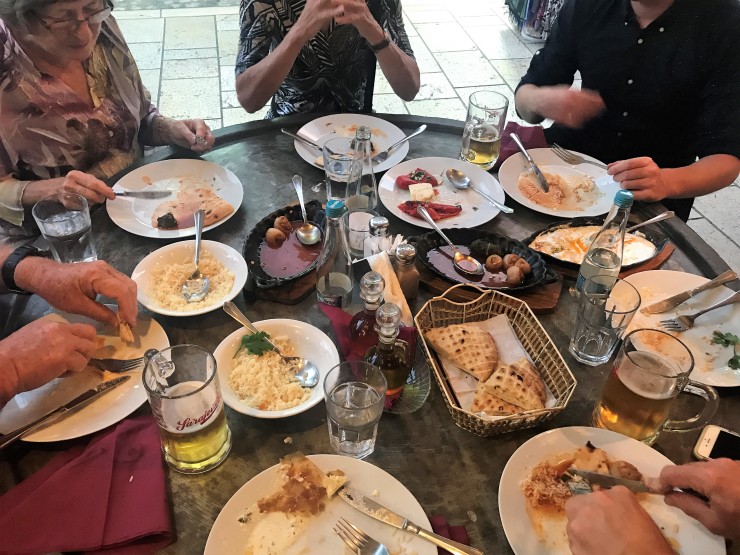 After dinner, I decide to be a good girl and head back to the hotel for a good night’s sleep. So far, Sarajevo is one of the best cities I have visited.. I love it here!
After dinner, I decide to be a good girl and head back to the hotel for a good night’s sleep. So far, Sarajevo is one of the best cities I have visited.. I love it here!






Great story. Please note that Bosnia and Herzegovina became independent in 1992. Hence the war. Hope you enjoyed the rest of your stay.
LikeLike
Omg thank you for pointing that out! A stupid typo on my part. And thank you for reading my post 😊
LikeLike